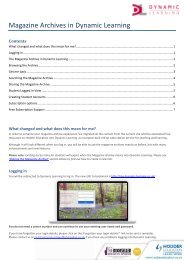POWER
OCR-A-Power-sample-chapter
OCR-A-Power-sample-chapter
You also want an ePaper? Increase the reach of your titles
YUMPU automatically turns print PDFs into web optimized ePapers that Google loves.
1 Power in medieval Britain c1000–c1485 1.3 A constant struggle for power: who ruled in the medieval period?<br />
Case study 5: The Wars of the Roses 1455–85<br />
This is the final twist in our tale of power in the medieval period – a struggle for<br />
power between two great noble families. Here is an outline of the main events.<br />
1413 Lancastrian Henry Bolingbroke, who had seized the throne from Richard II, dies. His<br />
son becomes Henry V.<br />
1413–22 Henry V is a successful monarch. England is peaceful and orderly and the king wins<br />
an important victory against the French at Agincourt in 1415. He dies of dysentery while<br />
fighting in France.<br />
1422–47 Henry VI is only nine months old when he becomes king. A council of nobles rules<br />
until he is 16. England is relatively stable. There are some disagreements among the nobles<br />
but for the most part they put their own interests second to the good of the kingdom.<br />
1437–50 Henry VI rules in his own right. Unfortunately he is a weak and ineffective king<br />
who dislikes making decisions. The French win back a lot of the territory that Henry V<br />
had taken. Senior nobles try to rule in Henry’s name but discontent arises because of poor<br />
government and increasing economic problems in England. A violent protest breaks out<br />
in 1450.<br />
1450–55 The situation worsens. Two of the most powerful nobles – the Duke of York and<br />
the Duke of Somerset – clash as each man thinks he was the right person to be Henry’s chief<br />
adviser. They fight a battle at St Albans. Somerset is killed.<br />
1455–61 Most nobles understand that civil war would be disastrous and hope that this will<br />
be the end of the dispute. They feel a duty to stay loyal to Henry VI. However, by 1459 the<br />
Lancaster family is beginning to suspect that the Duke of York plans to depose Henry VI.<br />
Each side builds up an army and a series of battles takes place. York is killed but his son,<br />
Edward, wins the decisive Battle of Towton. He deposes Henry VI (who flees from England)<br />
and makes himself Edward IV.<br />
1461–68 Edward gradually restores peace and stability, with the help of the powerful Earl of<br />
Warwick. By 1464, the remaining Lancastrians are defeated and Henry VI is captured before<br />
escaping to Scotland. However, Warwick and Edward IV fall out over what to do about<br />
war with France and Edward’s marriage (he had secretly married for love, but Warwick had<br />
expected him to make a political alliance). Edward has also refused to grant Warwick more<br />
power in government.<br />
1469–71 Warwick rebels against Edward and forces him to flee the country. However,<br />
Edward gains help from the Duke of Burgundy and returns with an army to defeat and<br />
kill Warwick in 1471. Edward orders the murder of Henry VI and his son to remove<br />
potential rivals.<br />
1471–83 Edward rules and England becomes relatively stable again.<br />
1483 Edward IV dies and his 13-year-old son becomes Edward V. The young king’s reign<br />
lasts only three months. His uncle, Richard, seizes the throne and becomes Richard III<br />
before Edward V is even crowned. Edward and his younger brother disappear – probably<br />
murdered.<br />
1485 Richard III faces opposition from those who believe he has seized the throne illegally.<br />
Rebels rallied around Henry Tudor, a distant relative of Henry VI. In August 1485, Henry<br />
invades England and kills Richard III at the Battle of Bosworth.<br />
Uncorrected proof<br />
FOCUS TASK<br />
How do you interpret the Wars of the Roses?<br />
Historians have long been fascinated by the Wars of the Roses. Over time, the events of this long period<br />
of civil war have been reinterpreted in different ways. The main lines of thinking can be summed up as follows.<br />
1 Study the outline of events above.<br />
a Choose five events that seem to support the first view. Explain how they support the view.<br />
b Now choose five events that support the second view. Explain how they support the view.<br />
Remember, the same event might support both views, depending on how you interpret it.<br />
PRACTICE QUESTIONS<br />
1 Describe two examples of<br />
the work of the Church in<br />
medieval England. (4)<br />
2 Explain why kings and<br />
barons clashed in the<br />
medieval period. (8)<br />
3 What was the significance<br />
of Magna Carta? (14)<br />
4 ‘The most significant<br />
problem faced by medieval<br />
monarchs was war.’ How far<br />
do you agree with this view?<br />
(14)<br />
KEY QUESTION REVIEW<br />
A Why did monarchs clash with their subjects in the period<br />
c1100–c1485?<br />
You have been collecting examples of the following causes of tension:<br />
powerful churchmen<br />
weak monarchs<br />
religion<br />
• money<br />
• war<br />
other.<br />
powerful barons<br />
1 Rank these causes in terms of their importance in causing tension.<br />
Explain your order, giving examples. These examples will be useful in<br />
your written work. Think about which you would use if you were answering<br />
this question:<br />
Explain why there was so much instability in England in the later 1300s and<br />
1400s. (8)<br />
B How did the balance of power between monarchs and subjects<br />
change in the period c1100–c1485?<br />
2 Look back to the chart on page 31. Decide how the power bars should look for<br />
each reign. Explain your chart.<br />
46 47




